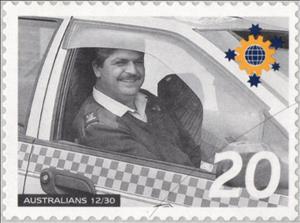Stamp: Advantage Australia - Australians 12/30 (Cinderellas 1993)
Advantage Australia - Australians 12/30 (Cinderellas 1993)
01 January (Cinderellas ) within release Australia goes into circulation Stamp Advantage Australia - Australians 12/30 face value 20 Unit
| Stamp Advantage Australia - Australians 12/30 in catalogues | |
|---|---|
| Colnect codes: | Col: AU 1993-03 |
Stamp is horizontal format.
One of 30 stamps used as a promotional tool by companies in Australia. To be used in conjunction with a passport book issued for that purpose. Values 10 & 20.Also in the issue Australia:
- Stamp - Advantage Australia - Australians 12/30 face value 20;
- Stamp - Advantage Australia - Australians 4/30 face value 20;
Stamp Advantage Australia - Australians 12/30 it reflects the thematic directions:
A car is a wheeled, self-powered motor vehicle used for transportation and a product of the automotive industry. Most definitions of the term specify that cars are designed to run primarily on roads, to have seating for one to eight people, to typically have four wheels with tyres, and to be constructed principally for the transport of people rather than goods. The year 1886 is regarded as the birth year of the modern car. In that year, German inventor Karl Benz built the Benz Patent-Motorwagen. Cars did not become widely available until the early 20th century. One of the first cars that was accessible to the masses was the 1908 Model T, an American car manufactured by the Ford Motor Company. Cars were rapidly adopted in the United States of America, where they replaced animal-drawn carriages and carts, but took much longer to be accepted in Western Europe and other parts of the world.
A people is a plurality of persons considered as a whole, as is the case with an ethnic group or nation. Collectively, for example, the contemporary Frisians and Danes are two related Germanic peoples, while various Middle Eastern ethnic groups are often linguistically categorized as Semitic peoples.
A symbol is a mark, sign, or word that indicates, signifies, or is understood as representing an idea, object, or relationship. Symbols allow people to go beyond what is known or seen by creating linkages between otherwise very different concepts and experiences. All communication (and data processing) is achieved through the use of symbols. Symbols take the form of words, sounds, gestures, ideas, or visual images and are used to convey other ideas and beliefs. For example, a red octagon is a common symbol for "STOP"; on maps, blue lines often represent rivers; and a red rose often symbolizes love and compassion. Numerals are symbols for numbers; letters of an alphabet may be symbols for certain phonemes; and personal names are symbols representing individuals.



